What’s Hot and What’s Not Among MS Therapies?


The newest kids on the MS block, disease-modifying therapies (DMT) such as Genentech’s Ocrevus (ocrelizumab) and Sanofi Genzyme’s Lemtrada (alemtuzumab), are attracting a lot of interest these days. But, some DMTs that have been around for more than two decades are still being prescribed by a lot of neurologists.
A new report on what’s being prescribed was released by the research firm Spherix Global Insights. It shows that the interferon class of DMTs is still hanging in there. Though their use has declined significantly compared to a year ago, interferon therapies such as EMD Serono’s Rebif, Bayer’s Betaseron, Biogen’s Avonex and Plegridy, and Novartis’ Extavia remain the current therapy for more than 25 percent of MS patients being treated with a DMT. Spherix expects the interferons to maintain their current share of MS patients through the end of 2018.
Rebif is the leader of the interferons
The Spherix report says that almost two-thirds of neurologists who were surveyed preferred one of the “high dose, high frequency interferons.” Rebif garnered the highest percentage of those doctors at 40 percent, followed by Betaseron with 23 percent. The neuros who prescribed Rebif said they did so because it’s effective, easy to use, and has been on the market a long time. It was also the only DMT for which some of the doctors volunteered other positive information, noting that its clinical trials were strong, its support by manufacturer EMD Serono is good, and it was usually covered by a patient’s insurance.
Interferons not the top choice for new MS patients
When I was diagnosed in 1980, no DMTs existed. Betaseron and Avonex came along in the mid-1990s and were the “magic bullet” at the time. Not so anymore.
In this survey, only 14 percent of the neurologists said they would prescribe an interferon for a young patient newly diagnosed with MS. The largest number of doctors, 41 percent, preferred one of the three oral DMTs: Aubagio, Gilenya, or Tecfedera. But almost as many, 37 percent, like glatiramer acetate, which is the generic for Teva’s Copaxone. Only 8 percent were ordering the monoclonal antibody DMTs Tysabri, Ocrevus, or Lemtrada for their patients.
Neurologists and their patients in the U.S. now have 16 DMTs from which to choose, balancing efficacy, side-effects, and cost. No doubt, we’ll see more shifts in what’s being prescribed down the road.
You’re invited to follow my personal blog at www.themswire.com.
***
Note: Multiple Sclerosis News Today is strictly a news and information website about the disease. It does not provide medical advice, diagnosis, or treatment. This content is not intended to be a substitute for professional medical advice, diagnosis, or treatment. Always seek the advice of your physician or other qualified health provider with any questions you may have regarding a medical condition. Never disregard professional medical advice or delay in seeking it because of something you have read on this website. The opinions expressed in this column are not those of Multiple Sclerosis News Today, or its parent company, Bionews Services, and are intended to spark discussion about issues pertaining to multiple sclerosis.







Mody
I don’t think there’s a HOT ms drugs yet,,,
Any drug doesn’t improves patient’s quality of life is nonsense
MicheleAnn Slater
Some of the drugs do improve quality of life. I've been on Tysabri (which this article does not even address) for 8 yrs and it has given me a quality of life back that I thought was gone forever.
Andrea Wilson
Where did you get Tysabri? My friend has p. progressive MS and no treatment that's stopping or putting her into remission, any thoughts?
AnnLouise Jones
I was diagnosed in 1994 but had been quite heat intolerant since @ age 12. I am now 59 and my desease course has been pretty benign. It was after undertaking subcutaneous fluid theory for a beloved pet when 3 months in he died. The following day I awoke with no sensation from the waist down. My diagnosis was made within the month. Betaseron was just on the market but I wanted no part of injections, or chemotherapy. I grew up in a cluster area in PA, but had moved to far northern CA in 1983, which turned out to be another cluster area.
Since my diagnosis I have treated symptoms with Baclofen, bladder meds and LDN therapy. The course of my deceased has, thankfully, been pretty benign, which I attribute to early retirement from a stressful legal secretarial position (I was granted Social Security permanent disability at the age of 45 following my diagnosis at age 35); and LDN, which I continue to take.
MicheleAnn Slater
So you are not on a disease modify drug . None of the drugs you listed are dmd's. They are for symptoms. I was dx in 1996. After ten years of interferons (Avonex, Rebif and Copaxone) -- none of which did anything to slow progression. I started Tysabri in Jan 2010. In the 8 yrs I have been on Tysabri I've only had one mild relapse (after being on Tysabri for 3 1/2 yrs. So, I'm almost 5 yrs relapse free. I was granted permanent disability in 2004 (after fighting for 4 1/2 yrs for it). MS caused me to leave the workforce after spending 20 yrs in a job that I loved -- Legal Administrator (Paralegal).
Chantal Vezeau
I have been off the betaseron now for 3years now, I do miss it because for 16 years I was able to work full time, my neurologist took me off because I'm not at secondary stage, I would like to try the Ocrevu inj but my doctor is afraid to try but I want to and my benefits will cover
Cindy
I would seek another neurologist that will as long as you don't have a high HCV which will put you at risk for PPL.